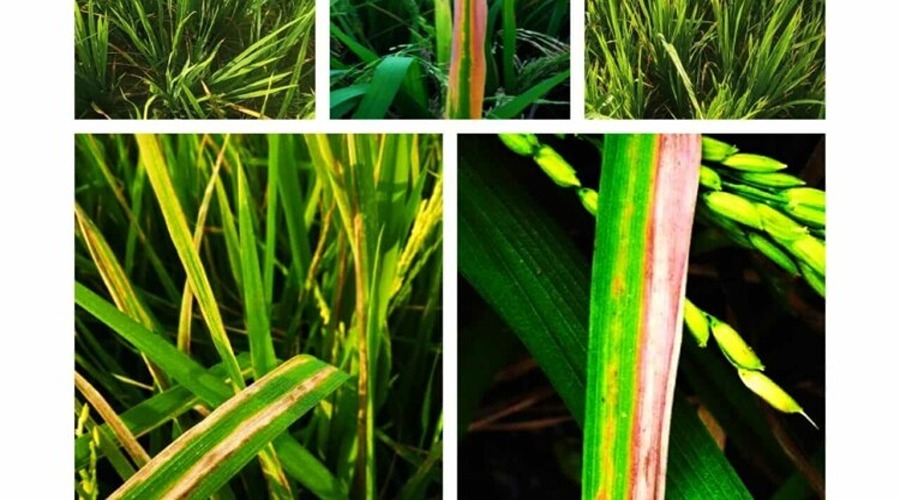Chickpea, also known as gram or Bengal gram, is a significant legume crop cultivated in many parts o ...
Rice is a staple food for a large portion of the world's population, making its cultivation crucial for food security. However, rice crops are susceptible to various diseases that can significantly impact yield and quality. Understanding these diseases, their causes, and effective treatment methods is essential for successful rice farming.
धान की फसल किसानों के लिए महत्वपूर्ण होती है, लेकिन विभिन्न प्रकार के रोग फसल की गुणवत्ता और उत्पादकता को प्रभावित कर सकते हैं। इन रोगों के सही समय पर पहचान और उपचार से फसल की रक्षा की जा सकती है।
यह रोग बैक्टीरिया द्वारा उत्पन्न होता है और धान की पत्तियों पर पानी के धब्बों के रूप में प्रकट होता है। प्रभावित पत्तियाँ समय के साथ पीली और सूख जाती हैं। रोग के प्रसार को नियंत्रित करने के लिए कीटनाशक और फसल चक्रण का उपयोग किया जाता है।

यह भी पढ़ें: धान में झुलसा रोग | ब्राउन प्लांट हॉपर
फंगल रोग जैसे कि पाउडर मिल्ड्यू और ब्लास्ट धान की फसल को गंभीर रूप से प्रभावित कर सकते हैं। पाउडर मिल्ड्यू पत्तियों पर सफेद पाउडर के रूप में दिखता है, जबकि ब्लास्ट पत्तियों और अनाज पर काले धब्बों के रूप में प्रकट होता है। उचित फंगीसाइड्स और रोग प्रतिरोधी किस्में इनसे बचाव में सहायक होती हैं।
धान की फसल पर कीट जैसे कि बिच्छू, सफेद मक्खी और काले तिल के आक्रमण से भी रोग हो सकते हैं। ये कीट फसल के विभिन्न हिस्सों को नुकसान पहुँचाते हैं और फसल की वृद्धि को प्रभावित करते हैं। कीटनाशकों और जैविक उपायों का उपयोग इनसे बचाव के लिए किया जाता है।
धान के रंग रोग मुख्यतः फफूंदी के कारण होते हैं, जो धान के दानों को रंगीन धब्बों से ढक देते हैं। यह रोग धान की गुणवत्ता को प्रभावित करता है और उत्पादन को कम करता है। रोग की पहचान और उचित उपचार से इनसे निपटा जा सकता है।

धान की फसल को विभिन्न रोगों से बचाने के लिए नियमित निगरानी, उचित कृषि पद्धतियों का पालन और समय पर उपचार आवश्यक हैं। फसल चक्रण, रोग प्रतिरोधी किस्में, और रसायनों का सही उपयोग रोगों के प्रभाव को कम कर सकते हैं।
धान की फसल को स्वस्थ और उत्पादक बनाए रखने के लिए रोगों का सही समय पर उपचार और नियंत्रण आवश्यक है। इससे न केवल फसल की गुणवत्ता बेहतर होती है, बल्कि उत्पादन में भी वृद्धि होती है।
Several diseases can affect rice crops, each caused by different pathogens including fungi, bacteria, and viruses. Some of the most common diseases are:
Rice blast, caused by the fungus Magnaporthe oryzae, is one of the most destructive diseases affecting rice. It can infect all parts of the plant, leading to significant yield losses. Symptoms include irregularly shaped lesions on leaves, stems, and panicles, which can eventually lead to the death of the plant.
To manage rice blast, farmers can adopt several strategies:
Use resistant rice varieties that have been bred to withstand the disease.
Implement proper field sanitation to reduce the spread of fungal spores.
Apply fungicides as a preventive measure or at the first signs of infection.
Bacterial blight, caused by the bacterium Xanthomonas oryzae pv. oryzae, affects rice plants by causing yellowing and wilting of leaves. This disease is spread through infected seeds, water, and contaminated soil, leading to severe losses in yield.
Managing bacterial blight involves:
Using disease-free seeds and practicing crop rotation to minimize pathogen buildup in the soil.
Ensuring proper water management to avoid the spread of bacteria through irrigation.
Applying bactericides and using resistant rice varieties.
Rice sheath blight is caused by the fungus Rhizoctonia solani. This disease affects the sheaths of the rice plant, leading to decay and reduced grain quality. Symptoms include lesions on the leaf sheaths and lower stems, which can result in lodging and yield reduction.
To control sheath blight, farmers can:
Practice proper spacing between plants to improve air circulation and reduce humidity around the crop.
Apply fungicides during the early stages of disease development.
Use resistant rice varieties where available.
In addition to specific treatments, adopting general preventive measures can help minimize the impact of diseases on rice crops:
Maintain good field hygiene by removing and destroying infected plant debris.
Monitor crops regularly for early signs of disease and act promptly to manage outbreaks.
Implement integrated pest management practices to reduce the reliance on chemical treatments.
0
0
Chickpea, also known as gram or Bengal gram, is a significant legume crop cultivated in many parts o ...
Mango is one of the most popular and widely cultivated fruits globally. However, mango trees are sus ...
The Brown Plant Hopper (BPH), scientifically known as Nilaparvata lugens, is one of the most notorio ...
Jhulsaa Rog, commonly known as "Blast Disease," is a significant threat to rice crops worldwide. Thi ...
Rice (paddy) is one of the most vital staple crops in the world, feeding billions of people globally ...
Wheat is a staple crop grown globally, but it is susceptible to various diseases that can significan ...
Gardeners and farmers often rely on chemical pesticides to protect their plants from pests and disea ...